#portuguese conquests
Text
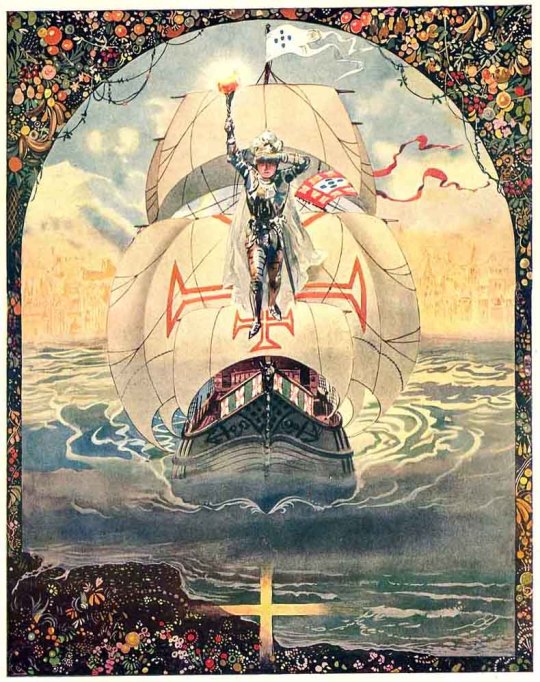
Frontispiece of "História da Colonização Portuguesa do Brasil"
Illustrated by Alfredo Roque Gameiro
#alfredo roque gameiro#art#portugal#portuguese#brazil#brasil#americas#new world#age of exploration#age of discovery#age of sail#conquest#europe#european#history#ship#ships#knight#torch#medieval#middle ages#torchbearer#armour
56 notes
·
View notes
Text



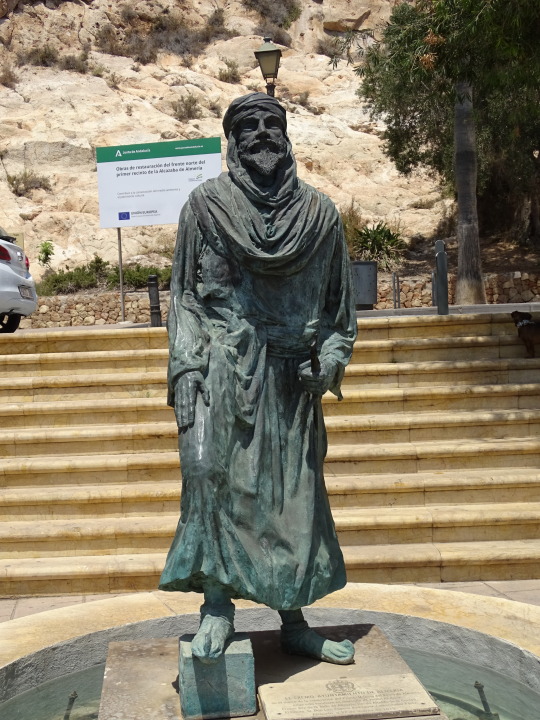
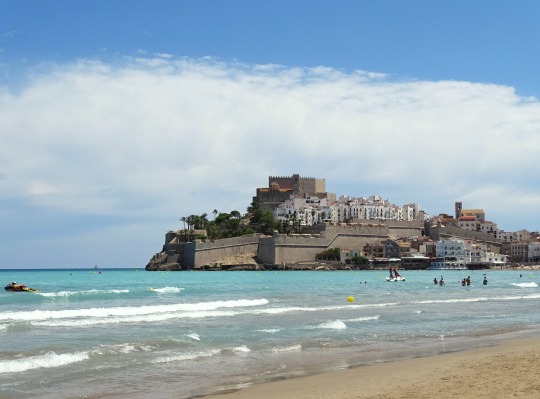


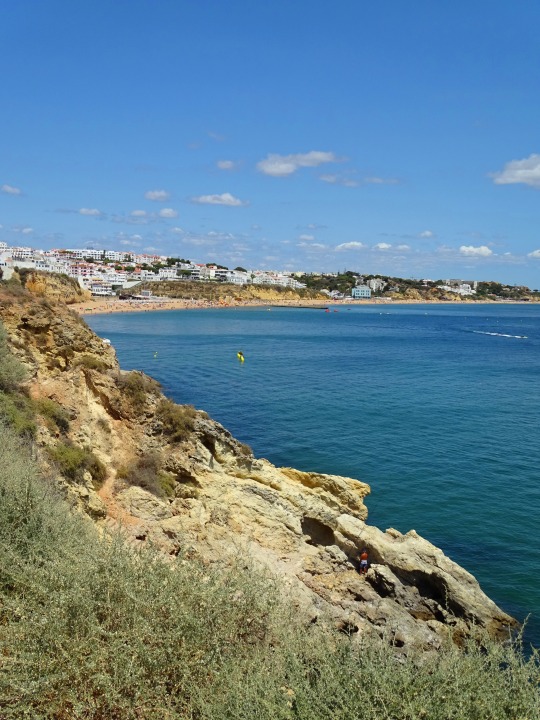




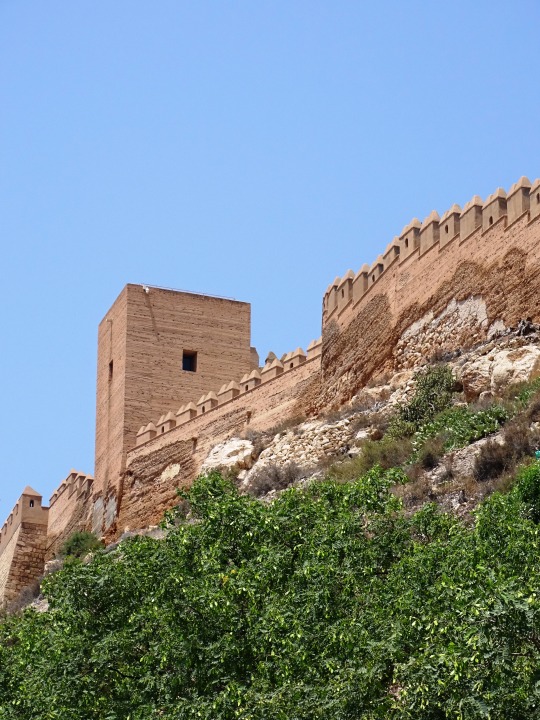

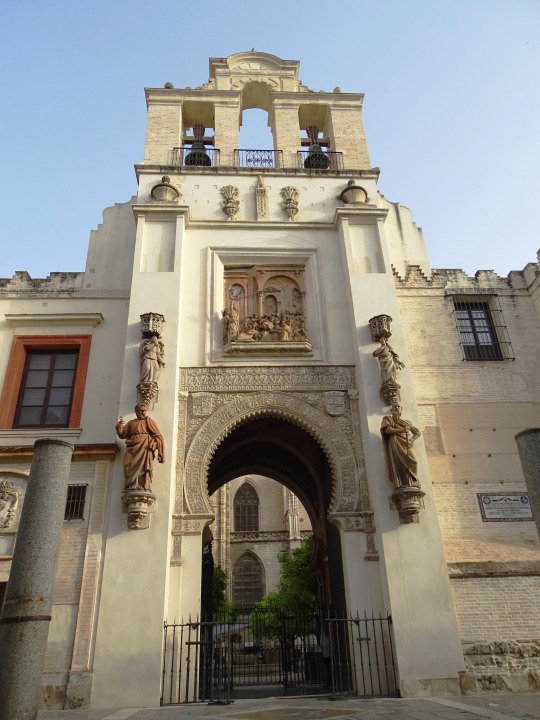

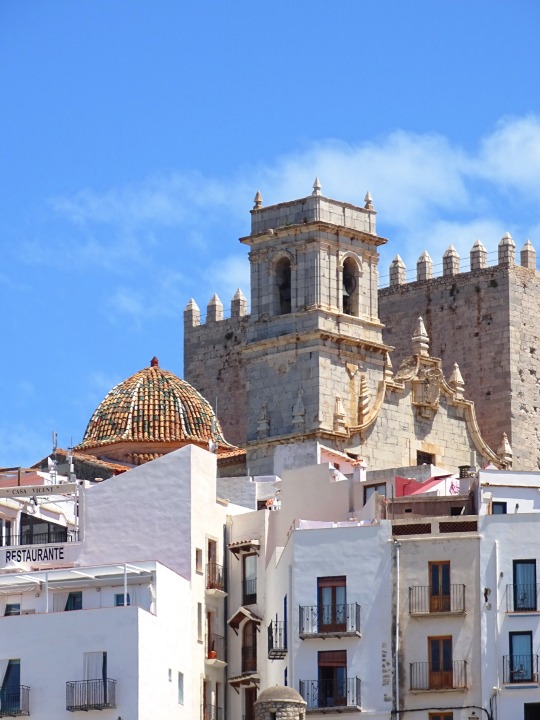



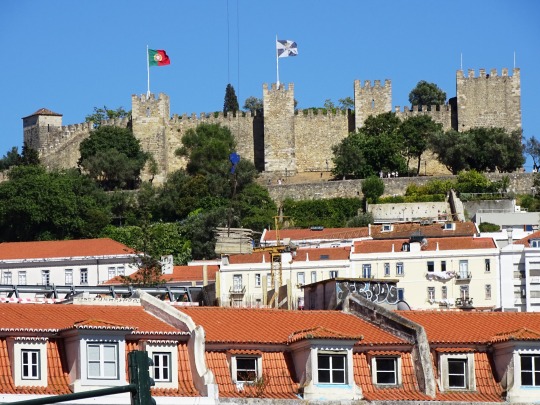
Islamic conquest of Hispania: Moorish troops led by Tariq ibn Ziyad land at Gibraltar to begin their invasion of the Iberian Peninsula (Al-Andalus) on April 27, 711.
#Alcazaba y Murallas del Cerro de San Cristóbal#Almería#Jayran al-Amiri#Reales Alcázares de Sevilla#Islamic conquest of Hispania#Tariq ibn Ziyad#begin#invasion#Iberian Peninsula#Spanish history#travel#Portuguese history#summer 2021#original photography#Sevilla#Castillo De La Calahorra#São Jorge Castle#Lisbon#Portugal#Spain#España#Gate of Forgiveness#Seville Cathedral#Castelló de Farfaña#Castillo de Peñíscola#Mediterranean Sea#Albufeira#Atlantic Ocean#vacation#27 April 711
3 notes
·
View notes
Text
An intro to the historical Zheng Yi Sao
Ruibo Qian's character in Our Flag Means Death is based on a real person, though like all its real pirates, she is a loose interpretation. In particular, the real Zheng Yi Sao wasn't born until 57 years after the real Blackbeard died!
In real life, she lived from 1775 to 1844. She was known by a variety of names; her birth name is usually given as Shi Yang. Zheng Yi Sao is the name most often used, which literally means "the wife of Zheng Yi" (more on him later), and you may also see variations like Ching Shih or Madam Cheng, depending on transliteration. Calling her Zheng, as Oluwande does, is good, or ZYS in fandom chat, but if fic writers crave a more personal connotation for a scene, Yang is a good choice for a given name consistent with the real woman. It's like the difference between Mr. Buttons and Nathaniel.
She was born in the Guangdong province, and many bios of her claim she worked on one of the boat brothels there, but this is speculation only.
When she married Zheng Yi, he was a successful member of a pirating dynasty, working as a privateer for emperors of Vietnam. The couple collaborated to unite six different pirate fleets operating off the Guangdong coast into a confederation, sealed with an agreement signed by the captains of each. Zheng Yi was informally recognized as the overall leader of the confederation until his death in a storm two years after the signing.
Zheng Yi Sao had the respect of other key figures in the alliance, and her smooth assumption of leadership was followed by a period of huge success and expansion for the pirate confederation, driving the Chinese government to desperation. This is where her reputation as a pirate "queen" comes from in real life, though I'm excited to see where the show goes with her fictional conquest of China!
In 1810, Zheng Yi Sao recognized that the confederation faced internal fractures and additional opposition, as Portuguese and British military forces allied with Chinese ships, so she led the confederation to bow out on a high, and use their immense power to bargain for a peaceful retirement, surrendering ships and weapons for pardons, supplies, and money. Although it's fictional that her crew was predominantly women, when Zheng Yi Sao surrendered, she did so accompanied by a delegation wholly composed of women and children who belonged to the confederation. At that time, the confederation consisted of 226 ships, 24 of which personally reported to Zheng Yi Sao.
If you're doing the math, she was only in her mid-thirties, and was far from done with life. She remarried, to one of her former captains, Zhang Bao, and accompanied him to the Penghu Islands, where he commanded a garrison. After his death, she returned to Guangdong and had another career of twenty-odd years, becoming the owner of a casino until her death at age 68 or 69 (nice).
She was one of the most successful pirates in history, both because of her power and her ability to survive it. I think she's neat as hell, and so have a lot of fiction writers! You might have encountered versions of her, or characters inspired by her, before, in things like Pirates of the Caribbean, the Bloody Jack novels, Assassin's Creed, and Doctor Who. It's fun to see a form of her in this! We can expect her arc to progress differently, but I hope having some context will help.
The most helpful things to note for the rest of the season for ofmd fans will be that Zheng is her surname, she wasn't really a contemporary of the other historical figures, and that her connection to sex work should not be treated as a fact, whether you want to include it in this fictional interpretation or not.
263 notes
·
View notes
Text
ENDER LILIES: Quietus of the Knights sequel ENDER MAGNOLIA: Bloom in the Mist announced for Switch
From Gematsu
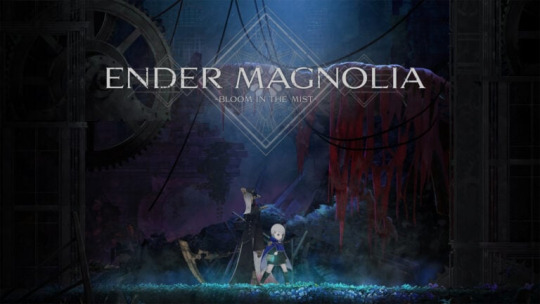
Publisher Binary Haze Interactive and developers Live Wire and Adglobe have announced ENDER LILIES: Quietus of the Knights sequel ENDER MAGNOLIA: Bloom in the Mist for Switch. It will launch in 2024. It will support English, Japanese French, German, Italian, Spanish, Portuguese, Russian, Simplified Chinese, Traditional Chinese, and Korean language options.
“We teased a sequel to ENDER LILIES: Quietus of the Knights nearly two years ago, and we have received countless requests from our online community for a second adventure,” said Binary Haze Interactive CEO Hiroyuki Kobayashi in a press release. “It is an honor and a pleasure to announce our next title with the help of Nintendo during such a prestigious event. We have much much to share in the very near future, stay tuned!”
Here is an overview of the game, via Binary Haze Interactive:
Decades after the Rain of Death, a new journey begins in the Land of Fumes, where mystical powers lie beneath the earth. The kingdom’s desire for conquest led to the creation of the Homunculi, machine-like artificial life forms prepared to execute the king’s will. A recent resource-harvesting mission gone awry caused toxic vapors to emerge from underground, driving both man and machine to feral madness.
As the Homonculi devolve into dangerous creatures, guide Lilac—an “Attuner” with the power to purify those infected by the fumes—on a quest to save the kingdom. With the help of friendly machines and spirits who fight in Lilac’s stead, fend off mechanized legions of lunging carcasses, cannonball-firing corpses and chainsaw-wielding goblins terrorizing the land.
Turn foes into friends by exorcizing corruption from enemy bosses. Wield their powers to add 30 different abilities to Lilac‘s combat repertoire in an enhanced battle system where she can equip up to four special abilities at once. Improve Lilac’s odds of surviving this hunt for lost memories by leveling up attack strength, HP, and armor.
Explore the depths, heights and far corners of the kingdom for lore-filled relics. Collect and trade gold for upgraded items at the Blacksmith’s storefront. Combine story fragments from the kingdom’s fleeing inhabitants with Lilac’s forgotten memories. Seek the truth in an atmospheric hand-drawn setting set to the soothing serenades of returning musical group Mili (Ghost in the Shell, Goblin Slayer) with a brand new original soundtrack available for purchase at launch.
More information will be announced on February 26 at 7:00 a.m. PT / 10:00 a.m. ET via the game’s official website.
Watch the announcement trailer below. View the first screenshots at the gallery.
Announce Trailer
Japanese
youtube
#ENDER MAGNOLIA: Bloom in the Mist#ENDER MAGNOLIA#ENDER LILIES: Quietus of the Knights#ENDER LILIES#Binary Haze Interactive#Adglobe#Live Wire#metroidvania#Gematsu#Heck yeah#Youtube
124 notes
·
View notes
Photo

French Expressions based on Other Nationalities
by u/Beurreboule
These expressions come from various online platforms, with a strict focus on those whose etymology can be linked to specific nationalities. It is important to note that this map is not intended to offend, but rather to explore the linguistic interaction between cultures.
I've picked expressions that are tied to people or nationalities. For instance, “To have the Portugueses sanded” (Avoir les portugaises ensablées) refers to a type of oysters, not the people of Portugal.
Here is the list of these expressions, along with their origins:
To take a Scottish shower (Prendre une douche écossaise):
This French expression dates back to the 19th century and refers to a hydrotherapy practiced at that time in Scotland. In a figurative sense, it describes a situation where a combination of sensations, events, or impressions swiftly transition from being positive to turning negative.
The English have landed (Les anglais ont débarqué):
In comparison to the British armies which, during the Napoleonic wars, were dressed in red.
To slip away the English way (Filer à l’anglaise):
Probably an alteration of the English "to take French leave", dating from the 19th century.
To talk like a Spanish cow (Parler comme une vache espagnole):
According to the most plausible hypothesis, it would be a distortion of the Occitan expression “parlar coma un gavach espanhòl” (to speak like a Spanish gabatch). The word “gabatch” designates here the mountain dweller from the Pyrenees.
A Spanish wanking (Une branlette espagnole):
The origin of this 20th century expression is obscure and mysterious.
A Spanish inn (Une auberge espagnole):
This expression was used in the 17th century to describe the poor quality of inns/hostels in Spain, which were widely used because they were on the road to Santiago de Compostela.
A German quarrel (Une querelle d’allemand):
The most commonly accepted theory is that the Holy Roman Germanic Empire was made up of numerous small states. These rulers frequently looked for opportunities to engage in battles with neighboring states, aiming to capture land and increase their power and influence.
To be drunk like a Pole (Être saoul comme un polonais):
This expression, which has become pejorative, was not so at its beginnings. After a decisive battle, the Polish lancers of Kozietulski in Spain in 1808 were paraded before Napoleon as heroic survivors of this elite unit. Jealous French generals, wanting to downplay the role of the Poles, claimed that they were drunk. The Emperor responded to them, "Well then, gentlemen, learn to be as drunk as the Poles!".
Another version states that Napoleon, in admiration, said, "One had to be as drunk as a Pole to accomplish that."
The Russian mountains (les montagnes russes):
The concept of Russian Mountains originated from toboggan races held on snow-covered hills, especially in the vicinity of Saint Petersburg. In the late 1700s, these races gained immense popularity, prompting entrepreneurs to explore the idea in other countries. This led to the development of rides using wheeled cars on tracks. In 1812, the company "Les Montagnes Russes" constructed and operated such rides in the Belleville district of Paris.
The term was subsequently used to describe roller coasters, and this analogy led to the emergence of the expression.
A Roman’s job (Un travail de romain):
From the reputation of the Romans for having accomplished Herculean works, especially the construction of aqueducts and ancient roads.
To be strong like a Turk (Être fort comme un turc):
This expression comes from the 15th century and refers to the period of the Ottoman Empire when the Turks achieved many conquests through their sheer strength and ruthless behavior, showing no mercy. Thus, during that time, the Turks represented the ultimate enemy, seen as unbeatable.
To be the Turkish head (Être la tête de turc):
This expression is based on the entertainment found at French fairs in the late 19th century. These amusements involved gauging one's strength by hitting a head wearing a turban, evoking the stereotypical image of a Turk.
To send to the Greek calends (Renvoyer aux calends grecques):
From the Calends, which were not Greek but Roman, is an expression used by Suetonius in The Twelve Caesars to say “never”.
To go get lost at the Greeks (Aller se faire voir chez les grecs):
This expression indirectly refers to the alleged common homosexuality among Greeks since ancient times, including practices like pederasty. Notably, Plato's work "The Symposium" illustrates this, featuring figures like Socrates.
355 notes
·
View notes
Note
Hi!
Do you know if there's any Jewish history in EH? There are a lot of old (pre-Inquisition) Jewish buildings/art in Spain, Catalonia, and Portugal, but I'm not sure if there are EH. I'm just curious, since I've learned a lot about Jewish life in Spain before the Inquisition, but never about Jewish life in EH, if there even was any.
Thank you!
Kaixo and thanks for your message!
Of course there's Jewish history in EH! In Gipuzkoa there never was a big community, as well as in Araba, with the exception of Guardia. In Bizkaia, Balmaseda was the biggest center for Jews, but sadly they were forcibly expelled around 40 years prior to the expulsion from Castile. Jewish people flourished mainly in the southern side of Nafarroa in Muslim times: there were thriving Jewish communities in Lizarra, Tutera, Tafalla, even Iruña.
Luckily this didn't change after the Reconquista! Jewish people were mainly merchants and moneylenders - profession banned for Christians - and they would work with peasants and nobility alike. They were also wine makers, and this wine was very much appreciated not only in the kingdom of Navarre, but also in Aragón and Castile. Navarrese kings supported Jewish communities and welcomed any Jew from other region.
There's a tragic but moving story about this time. The Jewish community of Gasteiz was forced to leave, but they agreed to hand over their cemetery to the city on the condition of respect the ground and don't build on it. The promise was respected for 460 years until 1952, when Jewish representatives agreed with the town hall that the ground was available for any use. Nowadays, it's a park with this monument to Jewish people. The neighborhood is called Judimendi, "the mountain of Jewish people".
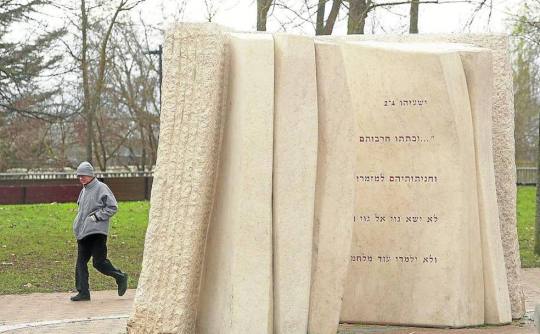

In fact, when the kingdom of Castile ordered the expulsion of Jews from Castile, most of them moved to the kingdom of Navarre. But after the conquest by Castile in 1512, Jews and Muslims were effectively expelled from their home. Most of them didn't go too far, just across the border, to Baiona.
Baiona welcomed Basque, Spanish and Portuguese Jews, gathering a very important community that led to call the town the little Jerusalem at one time. There's a much modern legacy there than south the border, for example, there's still a functioning synagogue.


After the French revolution, Jews were reocgnised the same rights and duties than any other French, so they kept their businesses and in Baiona, many of them devoted themselves to chocolate - still one of the best in Europe, I must add.
But during WW2 and nazi occupation, maaaany of these Jewish people were captured and led to extermination camps. The community didn't die, though, and they welcomed a new wave of Jewish refugees in the 60s due to the French-Algerian war.
René Cassin, one of the fathers of the Declaration of Human Rights, was a Jew from Baiona, btw.
Nowadays in Euskadi there are just around 300 Jews, while in Iparralde this figure is bigger but not super high (just around ~3,000 in the whole Aquitaine).
53 notes
·
View notes
Note
Colonialism is a disease
Imagine being an Arab Muslim and having the audacity to call someone else a colonizer. The illustration below is a snapshot of Islamic colonialism and occupation of other people's lands, from the 7th-9th centuries. Islam went on to attack, destroy, occupy and colonize vast swaths of Europe and southeast Asia, as well as what is now called Turkey.
The world has witnessed many colonial empires since the beginning of time. Most notably, the Mongols, Persians, Greeks, Romans, Babylonians, Egyptians, Islam/Ottomans, Portuguese, Dutch, French, Spanish, British, and American. The only empire that didn't take land, even after winning world wars, were the Americans. They actually gave back the Philippines. But I digress.

All of these empires were in large part, created by bloody conquest, and built on the backs of the newly subjugated. The Hebrews were, famously, slaves in Egypt.
No one seems to teach this in the west, focusing more on the Romans, but of all the colonialists, one of the most deadly brutal and expansionist empires were the Muslims aka the Islamists. The Islamic empire expanded by sheer, from Medina (where Muhammad massacred and enslaved the 50% majority Jewish population) all the way into western North Africa, much of Europe, and large populations of Southeast Asia (Indonesia, Malaysia, parts of India now called Pakistan, etc).
As it expanded using violence and fear, Islam literally took 100 million slaves out of Africa, and was responsible for one of the greatest mass murders in history: killing 10 million (or more) on the forced march from their homelands to the Middle East.
Some examples of Islamic slavery include the Al-Andalus slave trade, the Trans-Saharan slave trade, the Indian Ocean slave trade, the Comoros slave trade, the Zanzibar slave trade, the Red Sea slave trade, the Barbary slave trade, the Ottoman slave trade, the Black Sea slave trade, the Bukhara (Uzbekistan) slave trade, and the Khivan slave trade from which Islam took millions of slaves out of Persia to the Islamic khanates. There are Arab/Islamic societies today (Libya, a well-known example) that still trade slaves.
Compare this to Israel. Israel/Judea was never colonial nor expansionist. The Hebrews (aka Jews) were often properties of and were subjugated by, colonial empires, including the Islamic colonial empire.
They Hebrews themselves, as noted above, were most famously slaves of the the colonial Egyptian empire, some 4,000 years ago, before being murdered and subjugated by Islam starting in the 7th century. Somehow able to escape Egyptian tyranny through their own efforts (some say, by the grace of Hashem), the Hebrews settled in their current indigenous homeland 3.600 years ago - a small area by global standards, smaller than Belize, Albania, or Montenegro. They were happy there, and even at their peak, did not attempt to force convert others or expand much beyond their lands.
As historian Barbara Tuchman wrote, Israel is “the only nation in the world that is governing itself in the same territory, under the same name, and with the same religion and same language as it did 3,000 years ago.” Despite all the occupations and forced exiles, the Jews/Hebrews/Israelites have maintained a continuous presence in Judea/Israel/Samaria for some 3,600+ years. And even though Israel was granted modern statehood in 1948, it is one of the oldest continuously maintained countries in the world.
The 'modern' state of Israel came to fruition post WWII, in 1948; the redefinition of borders and modern statehood after the fall of the big colonials was in no way unusual to Israel. Many country's modern borders came to be defined in the post colonial period (post WWI & WWII). While Israel and Lebanon and Iraq and Iran and Syria and Egypt were all ancient civilizations, dating back thousands of years, modern statehood came in the 20th century: For example, statehood was granted to Egypt in 1922; Saudi Arabia and Iraq in 1932; Lebanon in 1943; Indonesia, South Korea & Vietnam in 1945; Syria & Jordan in 1946; India & Pakistan in 1947; Israel, & Myanmar in 1948; Laos, Libya & Bhutan in 1951; Cambodia in 1953; Morocco, Sudan & Tunisia in 1956; Ghana & Malaysia in 1957; and so on.
The problem is, the tribalism and supremacy of Islam, can't stand that it's once-conquered land is now in the hands of the original owners. Islam believes that once it puts a flag in the sand somewhere, it's theirs.
Oh, and by the way, Andalusia (Spain) is next in Islam's sights.
#islam#colonialism#colonialist#colonizers#israel#secular-jew#jewish#judaism#israeli#jerusalem#diaspora#secular jew#secularjew#Islamic jihad#jihad#Hamas#taliban#Isis#Iran#gaza#Samaria#judea#samaria#judea and samaria#jihadis#hamas#hamas war#iran war#islamists
79 notes
·
View notes
Text
So you want to write about horses.
Specifically, you want to write about horses in your medieval-inspired fantasy novel, rpg, or daydream fantasy. Knights in shinning armor on noble steeds, damsels in distress(or not!) on fine prancing mount, or an evil sorcerer cackling on a fierce charger above your poor tandem MCs.
Whatever it is you're imagining, a medieval horse appears. But you know nothing about horses. I can help.
(If you would like to begin with my first basic Basics post, start here)
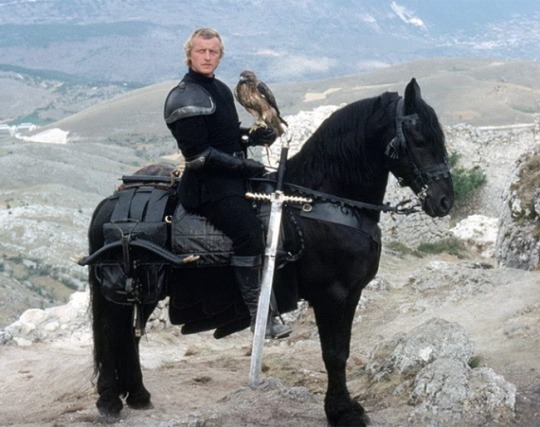
^ When thinking knight, you're probably imagining a horse like this.
Preface: When talking about fiction, there is always a question of historical accuracy. That is wholly up to you. But you will at least, after reading this, know more of the historical fact involving horses, and certainly know about some of the more commonly-complained about fallacies involving horses in media.
Now, the above still is from the film Ladyhawke (1985), which is often credited for popularizing the Friesian breed in the United States. I can almost guarantee you have see a Friesian in a film or on TV. The recent series Shadow and Bone had a central character ride a Friesian in one episode. They epitomize the romantic nobility and grace of knights. Except they don't.
The horse you see above came into existence in 1879, primarily as a harness and agricultural use horse. Horses known as Friesian horses have existed since the 11th century, but those horses were completely different from the breed created in the 19th century. The modern Friesian is a trotting breed, made to pull carriages and look beautiful doing it. They have a long back, short neck, and due to inbreeding, a host of nasty genetic problems including dwarfism, aortic rupture, hydrocephalus, and megaesophagus.
However, breeds that trace ancestry back to beyond the middle ages do exist, and they have been breed to look much the same for generations. Introducing:
The Barb/Berber Horse

^Kinda just looks like A Horse™
The Barb comes from North Africa, and was spread into Europe through the Muslim conquest of Spain, where the breed mixed with the native Andalusian breed to create the Spanish Jennet, which is possibly the most widely successful horse breed in all of history. The Jennet is currently extinct*, but due to its durability, it was the horse used by the Spanish AND the British to invade the Americas, and descendants of the Jennet survive in local breeds from Argentina to Canada.
*a revitalization breed does exist of the same name
The Andalusian/Lusitano/Pure Raza Espanol

^The true Fabio of horses, known for thick flowing locks and sweet dispositions
Possibly the horse that most strongly resembles the ancient knighly horse, this noble creature used to be the preferred horse of film, before the Friesian rise in popularity. Horses of Spanish bloodlines are Andalusian, horses of Portuguese bloodlines are Lusitano, but the characteristics of both breeds are nearly identical. They are also known for a fancy 'high stepping' movement, in which they raise their knees higher than other breeds naturally.
The Arabian

^Note the narrow, 'dished' face and raised tail, breed characteristics
The ancient horse of the desert, made famous through books such as The Black Stallion, King of the Wind, and films such as Hildago. These horses are known for their stamina and intelligence, and were traditionally used as war horses by the desert tribes of the Arabian Peninsula. The Arabian has descendants in almost all modern breeds, as it is used to add strength and stamina to the original stock, despite being a relatively small horse. During the Napoleonic wars, this horse became the prized war horse of Europe as well, with Napoleon himself preferring to ride Arabians into battle.
The Mongolian Horse
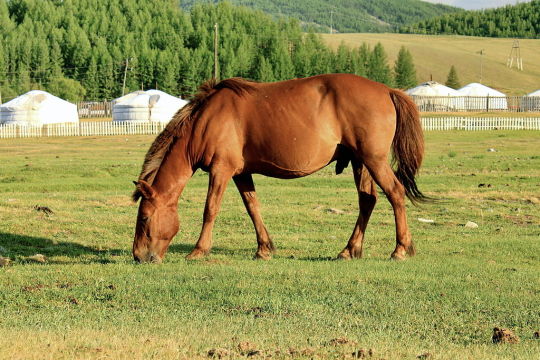
^Thick head, thick body, this horse is made to survive winter on the steppes
Introduced to Europe from the Hunnic invasions that ended the rule of Rome, the Mongolian horse is made to survive, thrive, and run in harsh cold weather. This horse allowed Ghengis Khan and his soldiers to conqure one of the largest empires to ever exist, from Korea to Poland. This compact horse would have mixed with the native stock of Russian, Eastern European, and Germanic tribes to help create the ancient northern horses, resulting in a thicker breed of horse in the north, and a lighter breed of horse in the south of Europe. Modern-day pony breeds such as the Exmoor, Fjord, Icelandic, and other have been found to have genetic ties to the Mongolian horse.
These horses do not exactly look like the modern image of knights on massive horses, but it is useful to remember that 1. people back then were a lot smaller and 2. horses back then were a lot smaller. Of course, there were hundreds of other local breeds during the middle ages, but many have been modernized and become today's sport, work, or pleasure horses.
During the middle ages, horses were not actually defined by breed. They were defined by the work the horse was suited and trained to preform. There were five main types of medieval horses.
The Destrier
Also called The Great Horse for its size, strength, and price, this horse was the renown mount of knights and kings in battle. These horses were highly trained for battle, and could be taught to do such things as striking out at soldiers in front, kicking at soldiers from the back, and even leaping all four feet in the air to protect it's rider. They would wear the most armor, and these horses would likely be closest in appearance to the modern Andalusian.

^Ornate heavy armor on a model horse. This armor was made for a horse not much more than 15hh, what today would be a small horse.
The Courser/The Charger
A lighter horse than the destrier, the courser is also a warhorse, highly trained and well-bred, but a little less expensive. A knight might not be able to afford a destrier, especially as a minor knight, but every knight should have a courser. The Spanish Jennet is the epitome of the medieval courser, and in fact was the horse used by Richard II. According to Shakespeare, the horse's name was White Surrey, although other sources claim the horse was Roan Barbary, and was a Barb or Berber horse*.
*Bought from Spain and likely a cross of Spanish and African blood, so a Jennet. But Jennet was also a classification of a horse type in those days, so, sources are muddled.
The Rouncey
The 'average' horse of the time, this horse was used mainly for riding, but could sometimes be ridden into battle if trained properly, and were the preferred horse for lower-class fighters such as archers or men-at-arms. As it described a riding horse, these horses came in all shapes and sizes, from all lineages, and in all colors. In peacetime they could be used to draw carriages or work fields. A proud and expensive destrier would never be caught pulling a plow.
The Palfrey
A highly-bred, highly trained horse, this horse is a high quality riding horse known for a specific gait, called an ambling gait. This horse had a special pattern of moving its feet that gave the rider a considerably more comfortable ride than the traditional 4 gaited horse. After the middle ages, these horses almost disappeared, only to be recovered in the Americas in the form of 'gaited' horses such as the Paso Fino, the Rocky Mountain Horse, the Missouri Foxtrotter, and the Tennessee Walking Horse. The Icelandic horse has also retained the special Tölt gait that may* be the exact gait of medieval ambling horses.
*may, I am not a gaited horse expert.
The Packhorse
This describes any kind of horse, usually a rouncey, that is used not for riding but to carry supplies. Packhorses could also be mules, donkeys, and ponies, so long as they could carry weight for long miles. These were supply horses, carrying food, weapons, tents, whatever else may be needed.
Knights, Horses, and the Battlefield

^ What an incredible creature of power and nobility. The man is fine too, I guess.
Now, if you have seen the above scene, you have probably seen The Hollow Crown, a historical drama with a few late Medieval battle scenes. In these scenes, knight clashes against knight in a furious charge, leading to pitched battles on horseback. I'm not going to say that never happened, but by and large cavalry was directed against infantry, not other cavalry, or used to conduct maneuvers requiring speed and surprise, such as a charge, a circling maneuver, a bluff retreat and most importantly, to chase down routing enemy soldiers. A knight on horseback was most effective in close quarters against unmounted and surprised soldiers. Lances were the primary weapon, allowing a mounted warrior length to spear and batter down at enemies, and a sword was secondary, as it had a shorter length, and would be used if a mounted warrior was surrounded by infantry or in battle against another knight. Throughout the medieval period, horses sometimes were removed from the fight all together due to unfavorable land, and kept in reserve to either help the army flee or to chase down the fleeing enemy.
Hungry for more?
There are many sources out there to learn more about the medieval period and knights in particular. I would highly recommend that you not look at Medieval Times sources, if only because better sources are out there. I enjoy the videos produce by Jason Kingsley CBE (Yes, that Jason Kingsley CBE) on his Modern History TV YouTube Channel, and find them to be accurate as far as I'm aware.
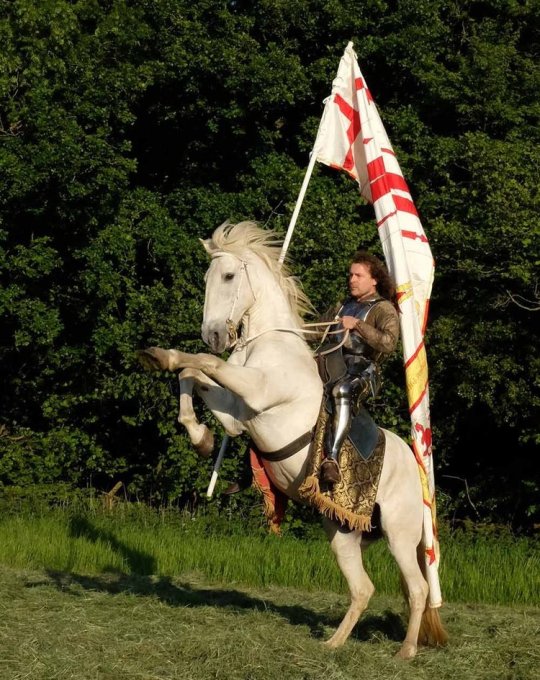
^ Jason Kingsley and his horse Warlord, in costume. I've sent marriage proposals but I've not yet received a reply.
That's all for this post. I'll have more when I feel like it, and send me questions if you want to know more about specific things or need a writing question answered
Reblogs welcome and encouraged
@jacqueswriteblrlibrary for wider reach
#writing#writeblr#writing horses#how to write horses#writer advice#writing help#writeblr community#writers on tumblr#writers#writerscommunity#creative writing#horses#how to write#advice post#medieval knights#writing medieval horses#horses in film and media#writing fiction#writer stuff#writing fantasy#writing historical fiction
80 notes
·
View notes
Text
Yan!Julius Caesar Random Headcanons
❝ 📜— lady l: I love writing these random headcanons and if you guys want more historical characters feel free to send them! If you're curious about how he is yandere, I posted a general headcanon of him, which you can read by clicking here. Here are historical facts and some additional ones from my head. I hope you like it and good reading!! ❤️
❝tw: not entirely historically accurate and perhaps murder (?).

Julius Caesar was born in 100 BC and became an important Roman military and political leader. His conquest of Gaul (present-day France) and his successful campaigns contributed to his rise to power.
In 44 BC, Julius Caesar was appointed dictator for life by the Roman Senate. This move sparked concern among senators, leading to a plot that resulted in his assassination on March 15, 44 BC, known as the "Ides of March". The man did not last long as a dictator.
Julius Caesar played an important role in reforming the Roman calendar. The Julian calendar, introduced in 45 BC, was an adaptation of the lunar calendar to the solar year, forming the basis of the modern Gregorian calendar. So much so that the month of July is in his honor.
Julius Caesar formed a political alliance known as the First Triumvirate with Pompey and Crassus. They shared power and influence to advance their political and personal agendas. It didn't last long because soon they started fighting each other for power. A yandere obsessed with power, I dare say.
Julius Caesar is known for writing "Commentaries on the War in Gaul", also called as Commentarii de Bello Gallico, a series of accounts of his campaigns in the region. These writings offer valuable information about military tactics and life at that time. A great military commander and also a great fanfic writer.
There are reports that say that when he was 30 years old, he passed in front of a statue of Alexander the Great and wept because he had reached the same age and had not conquered as much as the Macedonian King. An inferiority complex, I would say.
The title "Caesar" became a dynastic name used by many Roman leaders after Julius Caesar. The first Roman Emperor, Augustus, was his nephew and adopted heir, and he adopted the title "Caesar" as part of his name. A curious fact is that many Brazilians have Caesar (César in portuguese) in their name.
In addition to his military achievements, Julius Caesar had a deep taste for literature and writing. He frequently exchanged letters and discussed poetry with various intellectuals of the day. A true cultured man and a renaissance ahead of time.
The death of Julius Caesar was one of the key events that contributed to the fall of the Roman Republic and the subsequent rise of the Roman Empire. His legacy has had a lasting impact on history and politics. Our man is credited as one of the greatest military commanders of all time.
Rumor has it that Julius Caesar had a secret superstition of avoiding black cats, believing them to bring bad luck. This contrasted with his image as a fearless leader. Poor kitty, so many powerful men were afraid of cats.
#history#yandere historical characters#yandere julius caesar#yandere julius caesar headcanons#julius caesar#headcanons#yandere headcanons#yandere history
138 notes
·
View notes
Photo

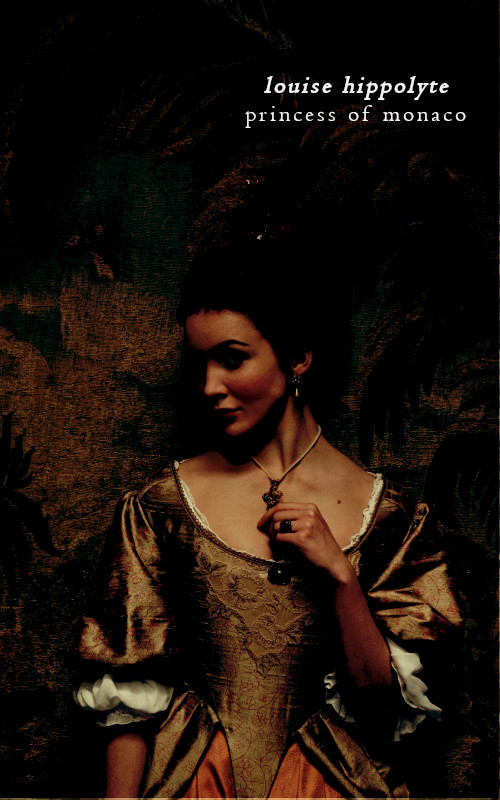
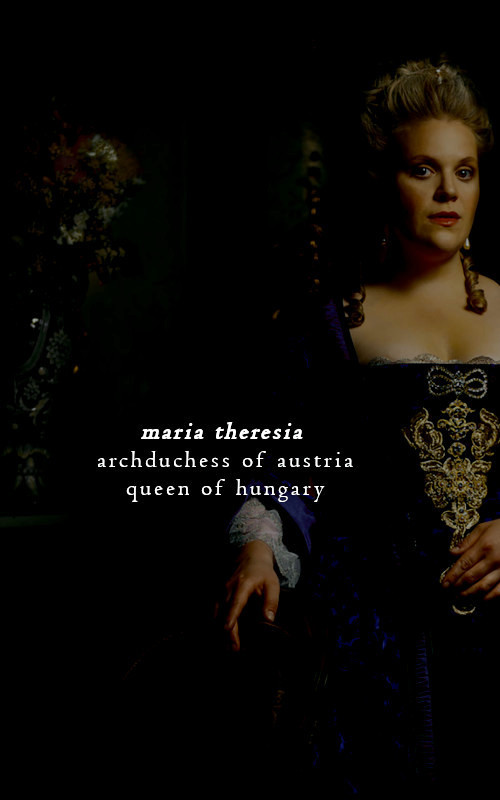
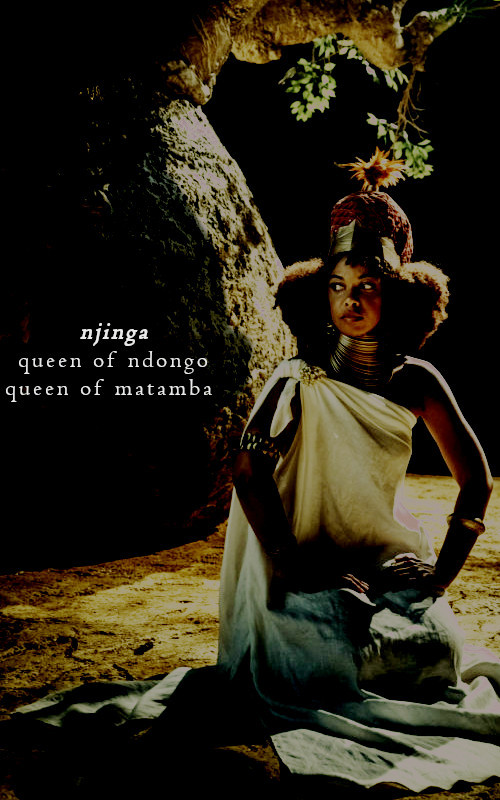
Favorite list of royal women | Regnant queens (who crowed herself queen without her husbands)
Been a queen regnant is not always easy specially when you are married but mor common than one would think. Here four of my favorite queen that were married and despite what society, and often the husband himself, thought decided that her lands by heritage or conquest were only hers to rule.
i. [1081-1116] Called The Reckless, Urraca was one of the most powerful reigning Queens of her time having inherithed the kingdom of León. Upon the death of her first husband she was convinced to marry Alfonso of Aragon the most successful warrior king of the Iberian Peninsula. It went horribly wrong. Personalities clashed and Alfonso emprisoned Urraca at one point. With Galicia rebelling and the Almoravides menace the spouses still went to war againts each other. Finally they separate and while Urraca still has a long way ahead and could keep most of her lands for herself.
ii. [1697-1731] Louise Hyppolite was at her time of birth the last Grimaldi. Monaco was under French control and it was decided that man from the French King family will be Louise’s husband and rule along with her. She was married and had to leave her land with her husband. Described as shy and submissive she did not enjoy her time at Versailles. When her father was ill she came back alone to Monaco and when he died she crowned herself Princess of Monaco with the people enthusiastic support naming her firstborn heir. There is no much her husband could do and though she ruled fr a short time she did it as the sole Princess.
iii. [1717-1780] Maria Theresia’s father Emperor Charles VI of the Roman Empire, did not prepared her to rule as he was convinced that her husband would rule for her. However, she had other plans and when her father died Maria Theresa, a 23 years old set to stablish her right as a moanrch against Prussia and most of Europe. She manage to gain ruling experience and be a monarch for 40 years. Though she deeply loved her husband she did not let him rule in her name and even refused to kneel in front of him when he was elected Holy Roman Emperor as she was of highest ruler. She was Sovereign of Hungary and Bohemia and Archduchess of Austria on her own right her husband being the consort.
iv. [1583-1663] Njinga was Queen of Ndongo after her father and brother. At the time with the Portuguese slave trade Njinga became a symbol of resistance to the Europeans. In order to gain power in the center of the region she married an Imbangala leader and learned the techniques and strategies of his people. However when she set to conquer the kingdom of Matamba and ruled there as the Queen as Matamba had tradition of female rulers. As she gained influence she was recognized as one of the great queens of the region at the time.
#historical women#women in history#maria theresia#njinga of ndongo and matamba#urraca of leon#louise hyppolite of monaco#maria theresa of austria#history
69 notes
·
View notes
Text
I mean it's not even just that Abed stops talking about Inspector Spacetime. He largely stops sharing his love of tv and movies in the same way he used to. I could be wrong but I think the Hickey incident is the last we hear of Kickpuncher. The posters stay up, but he doesn't really talk about his nerdier and more niche interests. He keeps up the treating life like it's a show on and off, but I mean he pretty much can't function without that. He focuses more on making his own stuff too.
But his specific references are like...tailored to the people around him more than ever. Like in Grifting 101, he jumps at the chance to show people con movies while everyone is briefly interested. In Analysis of Cork Based Networking, he talks about Bloodlines of Conquest, which is popular among the group. I mean, that's right after Troy left, so it's kinda like he's scrambling to find something he can share with others that doesn't remind him of Troy. That's probably in part why he reacts so strongly to Britta wanting to avoid spoilers. He is just holding so much inside and jumping at any chance to share his special interest that won't get him alienated.
It's just so rare for people to actually meet him where he is. Troy connected with him in a way nobody else did, but I think his presence also made others more patient with him. He acted as a sort of buffer I guess, people viewed dealing with Troy-and-Abed as different from just dealing with Abed. More whimsical and cute and palatable. Almost nobody has embraced Abed's undiluted self. Annie tries, she watches Portuguese Gremlins and does the missing lover footage and stuff, but I suppose it's hard to adapt their dynamic with a vital piece of it missing. People have their own issues yes, but it's just so sad to see him push so hard and tone himself down only to get very little in return.
89 notes
·
View notes
Text
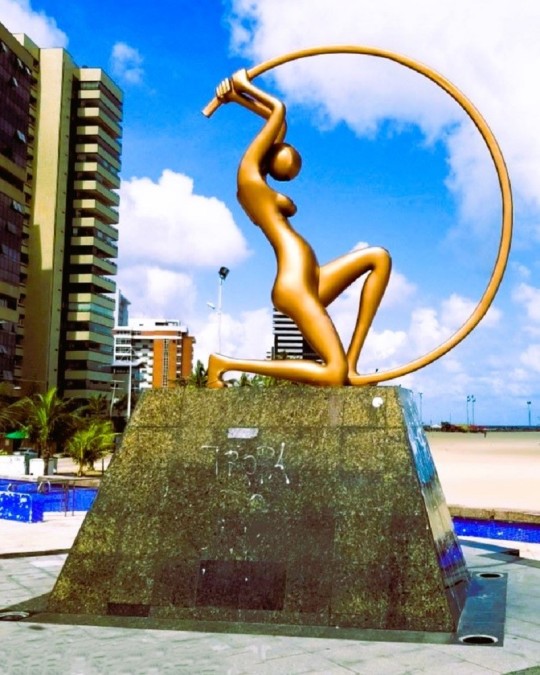
Statue in Praia de Iracema, Iracema beach, Brazil: Iracema Beach owes its name to a famous character created by the local writer José de Alencar. This novel is a gripping love story between a Brazilian Indian woman (Iracema) and a Portuguese settler at the time of the conquest of Brazil (Martim Soares Moreno), a leader in the fight against the Dutch invasion. There are five Iracema sculptures in the city, one of them located on this beach: the iconic "Iracema Guardiana". Wikipedia
43 notes
·
View notes
Text
After watching the Dagundong MV by Alamat, here are some MV shots with their possible historical references. Feel free to add more!

1. Here we have the inhabitants of the Philippine Islands before the colonizers' arrival.


2. The book with Alamat on the cover. Any Filipino who took Filipino Literature would instinctively know what this references: the novels by Jose Rizal, Noli Me Tangere and El Filibusterismo.

3. Erasure of indigenous practices and traditions in lieu of Christianity.

4. The lyrics references to the cedula or the taxes Filipinos were made to pay.

5. Spanish colonizers imposed the use of Spanish -based family names through the Catálogo alfabético de apellidos.

7. The Spanish conquistadores under the command of Portuguese Fernando Magellan went on a conquest to find Moluccas or the Spice Islands, in the guise of trade. All the while, they have also been on the ready for conquest.

8. Most indigenous peoples of the Philippines would get the honor of getting tattoos for their courage and bravery in battle. Every tattoo pattern or design would mean a significant symbolism.
9. Tomas in a stylized Katipunero hat
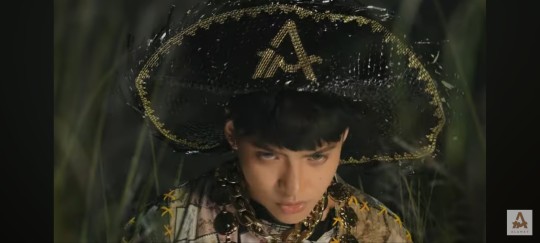

10. RJi and Jao representing the 19th century Filipinos. In this period, the Philippines has become a colony of Spain for 333 years.
They haven't released a BTS or the making of the MV vlog at the moment, but this particular track is on the OST of a movie to be released on December called Penduko. All those mentioned above are from what I've learned from my HS and/or college education. It has been alamat's mission to serve edutainment.
Please reblog and add if I missed some! Thank you so much!
#ppop rise#opm#alamat#alamat mo#ppop#alamat taneo#alamat alas#alamat jao#alamat tomas#alamat rji#alamat dagundong#philippine culture#philippines#alamat magiliw#6inoo
49 notes
·
View notes
Note
Historic ramble I suppose but as a historian I do get a bit offended when people refer to Al-Andalus simply as an "Arab kingdom(s)", since many of the previous people there who also invaded the region (such as the Visigoths) did convert to Islam and some retained their positions in power, and many of the "Arab" rulers were actually Imazighen.
It's more accurate to call it an Amazigh ""kingdom(s)"" (DNA research proves that many Portuguese and Spanish, especially those in the south like Algarve and Andalusia, have the most Amazigh ancestors outside of North Africa, which is why they are visually similar to one another and tend to have darker skin). Even more so than the Canary Islands, which were entirely habited by indigenous Imazighen (like the Guanches from Tenerife) prior to Castillian colonization. Which is sad because even if many Canarians today have indigenous Amazigh ancestors they culture has been nearly lost because of genocide (even if many Canarians are trying to reclaim their Amazigh/North African identity, which is a story for another time - and I wonder if you'd be interested in it).
You also mentioned this before I believe!
The way I started reading the first few words and was expecting some history revisionism (that’s usually what I get in my ask box about “Arabs and North Africa”) but I got pleasantly surprised. Cause yup while the conquest itself was done by both Arabs and Imazighen the people who actually mixed with the local and lived in Al Andalus were mostly Imazighen the Arabs left super fast their goal was just spreading Islam.
A southern Portuguese has more Imazighen ancestry than I, an Arabized Algerian, have actual Arab ancestry. The amount is still under 10% (I think it’s 6 or 8 I don’t remember the study exactly) but comparatively they have exactly 0 actual Arab ancestry.
I knew that Canarians were Imazighen (I’m also claiming Sicily by the way) but I didn’t know about the reclaiming of their Imazighen identity it seems really interesting!
15 notes
·
View notes
Text
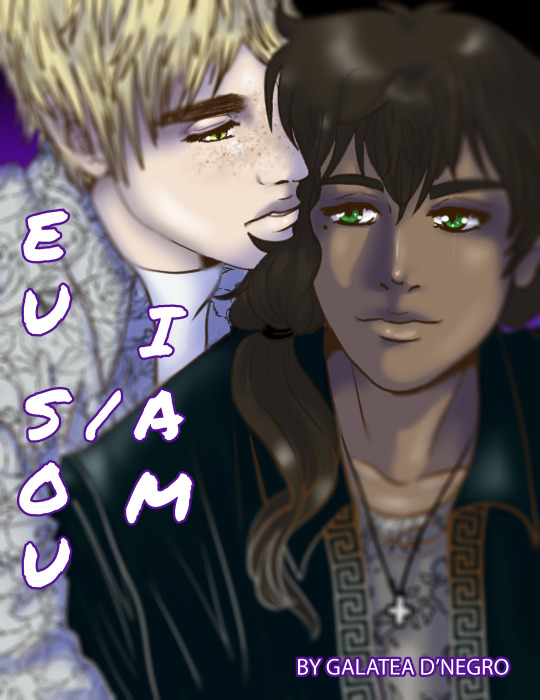
This is the intro of my longest fic this year and I'm publishing for this amazing week~. The cover is a drawing I prepared before but the story sees the light now~. Hope you like it and Happy EngPort Week!
Spanish version here.
Thanks to the amazing @imdedlikeu for helping me with the translation~
Day 1 (May 8th) ~ Surprise/Gift @engportevents
1 . O presente
At some point in human history, that had seemed an excellent idea; especially considering he had never been able to really see himself as he was, except at the beginning of time, through blurry reflections of lagoons and rivers.
Now, he wasn’t so sure nor happy with the image the mirror reflected.
“Querido, are you okay?”
The voice on the other side of the door, along with the gentle tapping of knuckles against wood, snapped him back to reality. The last couple of nights he was restless; a sensation he hadn’t felt for centuries, when wars awaited him at dawn, or when he’d embark on conquests at sea. The knots in his belly felt just the same.
“Yes, darling. I’ll be out.”
England rolled down the cuffed sleeves of his shirt, slipped into his coat and buttoned it up. He smoothed his hair, and walked out only to face a confused Portugal, who watched him expectantly.
“It’s been half an hour since you stepped into the bathroom, is everything okay?”
“Gabe, you know I like making myself desired“ he half-smiled, dispelling the worry from his own eyes - the other one could read him too easily.
“Are you playing at not telling me? Okay.” He asked with an arched eyebrow. Resigned, he stood with his hands at his waist. “We have some things to do.”
“Of course.” the blonde agreed automatically, he quickened his pace, moving forward.
Their masks slid on as they took a turn around the corridor, they walked side-by-side, a calmness that only kings seemed to own. Smiling with kindness and exquisite courtesy to those present; mortals of both nations working on the celebration of the Anglo-Portuguese alliance.
Many brave folks walked up to meet them and shake their hands; their first time they saw them under the Secret of the State; others were relieved they were there supervising everything, even if it seemed like a trivial tour.
“We’d like for you to see the preliminary inventory senhor Dos Anjos” a woman said speaking in Portuguese and holding a tablet, thin like a lectern.
“The celebration will the whole week with an event per day, Lord Kirkland.'' another man commented to the blonde, showing him on a cellphone with the chosen locations. He was unable to hide his excitement at being able to speak to his Fatherland.
It was a busy month, adding more work to what they usually had as nations. Eternal labor like themselves, navigating between mortal generations; meanwhile, those who show their support for what they were, at the same time, linked the countries together.
It was strange how the universe worked.
The british slowly began to drift from reality; on the one hand, while his consciousness was able to answer with his voice and mouth, registering what was being said to him, the shine in his eyes indicated he was looking at something else, within himself. Movement that the country at his side didn't miss.
“If you’ll excuse us, we must continue with our day,” the Portuguese said in perfect english. “Everything we’ve seen is perfect for us, so please continue as you have. Shall we, Arthur?”
“Of course, Gabriel,” his companion answered following his lead, “Later I will go over the details of the Tower of London. Proceed.”
“Yes, sir.” The small group answered, happy with the partial approval of Kirkland.
Taking it as a sign, the Lusitanian took the other’s arm and took him to one of the private offices he owned at the Portuguese Embassy, those where they met most frequently in London. The Anglo closed the door, leaning against it.
“Please, marido, tell me what’s going on. You’ve been lost all morning.”
Arthur walked quietly towards the other’s desk, sitting on the edge to better look at him.
“I apologize, I know I’ve been out of sorts.”
“Is there something wrong with one of your facets?” Portugal asks, wanting to make sure. “They seem to appear on days like these.”
“No, nothing like that. Everything is alright.” He answers calmly, making the other raise an eyebrow.
“Then?”
“Well… I was wondering, what sort of gift a husband gives on a six-hundred-and-fiftieth wedding anniversary?”
The Lusitaian’s eyes widened, and he laughed.
“All the zoning out and dramatic silence, because of this?” he walked towards him, calmer.
“It’s not just anything…” he defends himself with a childish pout, his cheeks puffed. Gabriel nods, getting closer and adjusting the blonde’s bangs.
“Of course it’s not, amor. But you behaved in a manner that made it much more serious.”
“It is serious. I don't know what to give you.” The brunette smiles more.
“We’ve celebrated many anniversaries at odds or upset with each other; sometimes even with an oceans distance between us.” He lovingly kissed his forehead “You know I’m happily content with your undivided attention and company alone. The privacy of intimacy is something that becomes more and more expensive in these times, especially between us.” He traces the other’s face with his finger, “A nice dinner, some wine, walking hand-in-hand alongside the beach and sailing at night…”
“Of course we’ll do that.” Arthur agreed, serious. “However-“
“It’s not enough.” The other finished. The blonde only nods. “Why?”
“I don’t know.” He shrugged, looking at him, unblinkingly, his eyes shine intensely. “Every fiber in my body is telling me this year we should do something more.”
“Is it the side of you that is human, or a premonition of the Old Magic?”
“A little bit of both.” He smiled, both bashful and mockingly. “I couldn’t give you any kind of gift last year.”
“What we did as a delayed gift was compensation enough” the dark-haired man added in a lascivious smile, touching the other’s silk green tie. “Especially when yo-“
“Don’t challenge my modesty, my dear, or I'll be forced to embarrass you here at the Embassy.”
“You seem so sure of that, Kirkland.” The other whispered.
“You know I am good at winning bets; I made it very clear when I was a pirate adorning his gypsy with jewels an-”
“Don’t try to change the subject, Artie.” Gabriel insisted. “Do you have an idea why you feel this way?”
“There will be a Blue Moon on our anniversary.” He said slowly, blinking, to appear more human. “You know what that means for my brothers and me.”
“Yes, the opposite of the Red Moon.” He answered bitterly, trying not to think much of it. “Do you have to stay on the Isles?”
“Of course not! It’s the day I celebrate with you, you fool.” he said in an obvious tone, tapping the other’s chest, slightly offended.
“Oi, don’t behave like a criança.” He sighted, “Then?”
“There will be an immense amount of Ancient Magic flowing from the surface of the veil, like Samhain.” He answered, excitedly. “And I was hoping we could go to Windsor Castle, in the west tower, there’s still-“
“Wait, the old room still exists?” He pulled back a bit, surprised.
“I’ve always conserved the old room, it was the first nuptial bed we shared together, why would I take it off?”
Gabriel’s blush was so sudden and intense, it made his husband laugh. The other one kissed the tip of his nose in response.
“I thought the tower was destroyed in 1853, after the fire.” He smiled slightly incredulous. “That's so… romantic, Arthur.” England showed his thanks through a gesture of pride.
“It is one of my many secrets; and since they’re mostly related to you, I can usually reveal them on special days like these.” His expression softened, holding him comfortable by the waist. “I think the memories that were made in that room will make the trip easier.”
“What trip… ?”
“I don’t want that old bed for something so banal,” he began, raising a thick brow, “of course I would be happy to do it, but there is something much more interesting.”
He smiled more.
“Let’s celebrate that day in the Lightning Wasteland!” Portugal’s eyes widen in genuine surprise.
“Wait... in the Dreamworld? But what about the events for this week that the humans have prepared? Will we not be attending?”
England made a dismissive gesture, “We’ll go, yeah, we’ll just be late…or have you ever seen a King or an Empire arrive anywhere on time? It’s in our blue blood, my love. Like I said before, you need to be desired.”
“The world doesn't work like that anymore, Arthur…” he sighs resigned, then the blonde laughted.
“It’ll work as we want it to, Dos Anjos.” His expression was mischievous. “Our alliance, our marriage, is the longest in history, let it be the ones to say how things are done. Mandates are not forgotten.”
Portugal blinked, smiling with amusement; he was well acquainted with Arthur’s sly attitude, when the Englishman was planning something mischievous. However...
“Okay, let’s do it.”
After six hundred fifty centuries, the human world was running out of marital surprises.
But nothing stopped his husband.
~~~~
#aph portugal#aph england#engport#porteng#engportevent#engportweek#engportweekevent#hws england#hws portugal#axis powers ヘタリア#hetalia#fanfiction#hetalia axis powers#aph#hws
44 notes
·
View notes
Photo

Spaniards and Portuguese in India and the Malay Archipelago, 1498-1580.
“Historical atlas”, William Shepherd, University of London Press, 3rd ed. 1924
by cartesdhistoire
Muslim merchants from Gujarat, based in Cambay, dominated maritime trade in the Indian Ocean in the 15th century, supported by Hindu and Jain financiers and an organized network of correspondents. The Malabar coast, a major pepper supplier, served as a hub for commercial interactions between Arab merchants from the Gulf of Aden or Oman and Chinese merchants – or their intermediaries – from Sumatra and Malacca. Muslim merchants primarily engaged in the spice trade.
The arrival of Vasco da Gama in Calicut in 1498 disrupted this system. In 1502, King Manuel entrusted him with commanding a second expedition aimed at eliminating all Muslim presence in the Indian Ocean. The Sultans of Gujarat and the Deccan sought assistance from a Mamluk fleet to counter the Portuguese, but it was defeated before Diu in 1509, paving the way for Portuguese conquests of Goa in 1510, Malacca in 1511, Hormuz in 1515, Diu in 1535, and Daman in 1539.
The Portuguese occupied the southwest coast of Ceylon from 1505 to access cinnamon, establishing a fort in Colombo in 1518. They controlled the north, west, and south coasts of the island, key areas for the cinnamon and precious stone trade.
The Moluccas were another target because the Banda Islands produced nutmeg, while Ternate and Tidore produced cloves. The Portuguese established privileged relations with the sultans of Ternate and Tidore, facilitating their settlement in Amboyna and Timor, despite the capture of Malacca from Sultan Mahmoud Shah.
The Portuguese monopoly endured until the emergence of the English East India Company and the Battle of Swally in 1612.
Meanwhile, Spain remained engaged in the spice race, aiming to connect America to the Moluccas and their spices. Following expeditions in 1525 (Loayza) and 1528 (Saavedra), Spain secured a definitive return route in 1565 (Urdaneta) and established settlements in the Philippines in 1571.
90 notes
·
View notes